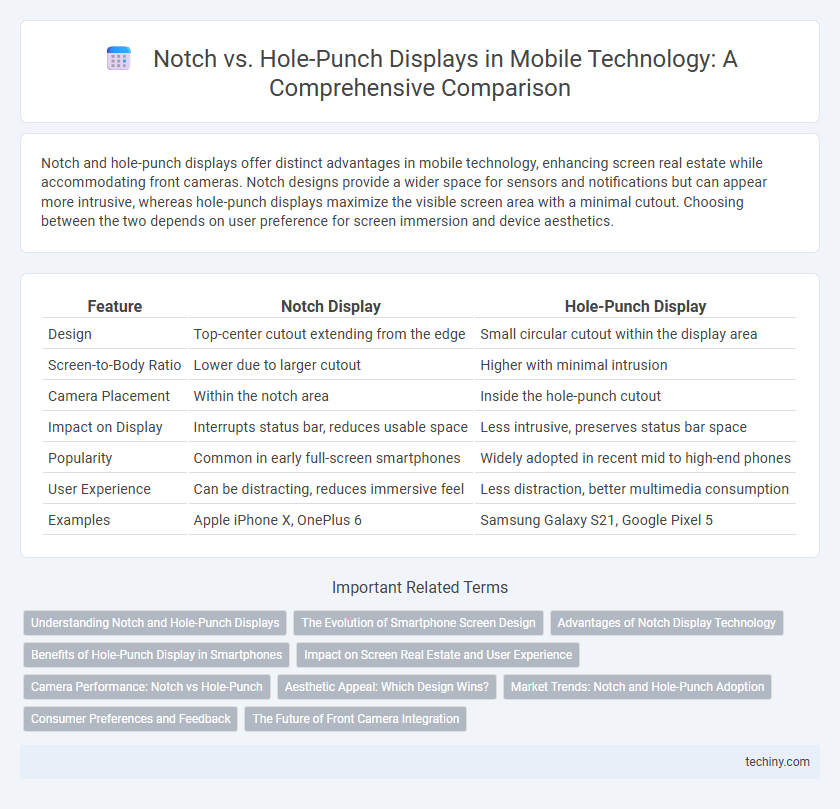Notch and hole-punch displays offer distinct advantages in mobile technology, enhancing screen real estate while accommodating front cameras. Notch designs provide a wider space for sensors and notifications but can appear more intrusive, whereas hole-punch displays maximize the visible screen area with a minimal cutout. Choosing between the two depends on user preference for screen immersion and device aesthetics.
Table of Comparison
| Feature | Notch Display | Hole-Punch Display |
|---|---|---|
| Design | Top-center cutout extending from the edge | Small circular cutout within the display area |
| Screen-to-Body Ratio | Lower due to larger cutout | Higher with minimal intrusion |
| Camera Placement | Within the notch area | Inside the hole-punch cutout |
| Impact on Display | Interrupts status bar, reduces usable space | Less intrusive, preserves status bar space |
| Popularity | Common in early full-screen smartphones | Widely adopted in recent mid to high-end phones |
| User Experience | Can be distracting, reduces immersive feel | Less distraction, better multimedia consumption |
| Examples | Apple iPhone X, OnePlus 6 | Samsung Galaxy S21, Google Pixel 5 |
Understanding Notch and Hole-Punch Displays
Notch and hole-punch displays represent two innovative approaches to maximizing screen real estate on smartphones by accommodating front-facing cameras and sensors. The notch is a visible cutout at the top of the screen, often extending into the display area, while the hole-punch features a small, circular cutout embedded within the screen itself. Understanding these designs is crucial for evaluating user experience, as notches can disrupt immersive viewing whereas hole-punch displays offer a less intrusive alternative, balancing aesthetics and functionality.
The Evolution of Smartphone Screen Design
The evolution of smartphone screen design highlights a shift from traditional notches to more subtle hole-punch displays, enhancing immersive viewing experiences while maximizing screen real estate. Notch screens, initially introduced to house front cameras and sensors, often interrupted content with their larger cutouts, whereas hole-punch designs utilize precisely drilled apertures, offering a minimalist and sleek appearance. This transition reflects manufacturers' focus on balancing front camera functionality with seamless edge-to-edge displays, driving advancements in mobile technology aesthetics and usability.
Advantages of Notch Display Technology
Notch display technology offers a larger uninterrupted screen area compared to traditional bezels, enhancing immersive viewing experiences for mobile users. It accommodates front-facing cameras and sensors without significantly reducing display size, balancing functionality with aesthetics. The notch design also allows manufacturers to integrate more advanced facial recognition systems for improved device security.
Benefits of Hole-Punch Display in Smartphones
Hole-punch displays enhance the immersive experience by minimizing screen obstruction compared to traditional notches, allowing for a larger usable display area in smartphones. This design provides a sleek, modern aesthetic while maintaining front camera functionality without compromising screen real estate. Users benefit from improved viewing angles and a less intrusive interface, making hole-punch displays a preferred choice for multimedia consumption and gaming.
Impact on Screen Real Estate and User Experience
Notch displays occupy a larger portion of the upper screen area, reducing usable screen real estate and sometimes obstructing content, which can impact immersive experiences in gaming and video playback. Hole-punch designs minimize screen intrusion by embedding the camera within the display, allowing for more uninterrupted viewing space and a cleaner interface. Users generally find hole-punch displays less distracting, enhancing overall usability and visual appeal on modern smartphones.
Camera Performance: Notch vs Hole-Punch
Notch displays typically house front cameras in a larger cutout, allowing for more advanced sensor arrays and better image quality, while hole-punch designs offer a smaller, less intrusive camera placement but often with simpler sensors. In terms of camera performance, notch cameras frequently deliver superior low-light photography and enhanced facial recognition due to additional sensors integrated within the notch. Hole-punch cameras prioritize screen real estate but may compromise on multi-sensor capabilities, affecting overall selfie and video call quality.
Aesthetic Appeal: Which Design Wins?
The hole-punch display offers a cleaner, more modern aesthetic by minimizing screen interruptions compared to the larger, more intrusive notch design. Consumers increasingly prefer hole-punch displays for their sleek look and enhanced screen real estate, contributing to a more immersive viewing experience. Smartphone brands like Samsung and OnePlus leverage hole-punch technology to appeal to users seeking cutting-edge, visually appealing devices.
Market Trends: Notch and Hole-Punch Adoption
The adoption of hole-punch displays in mobile technology is rapidly increasing due to consumer preference for larger screen-to-body ratios and unobstructed viewing experiences. Market trends indicate a decline in the prevalence of notches, especially among flagship smartphones, as manufacturers prioritize sleeker designs and enhanced front camera integration. Analysts predict hole-punch technology will dominate mid-to-high-end devices by 2025, reflecting a shift driven by advancements in display innovation and user demand for minimal bezel interference.
Consumer Preferences and Feedback
Consumer preferences in mobile technology highlight a growing favor for hole-punch displays over notches due to their minimal intrusion on screen real estate and modern aesthetic appeal. User feedback underscores the hole-punch design's superior ability to maximize viewing experience, especially in gaming and multimedia consumption, while maintaining necessary front camera functionality. Notch displays, though initially popular, face criticism for obstructing notifications and content, driving manufacturers to adopt more discreet camera placements.
The Future of Front Camera Integration
The future of front camera integration in mobile technology is shifting towards more seamless solutions like under-display cameras, reducing reliance on notches and hole-punch displays that disrupt screen real estate. Under-display camera technology enhances user experience by maintaining full-screen visibility without compromising selfie camera quality. Advances in pixel arrangement and AI image processing are driving this trend, promising a truly bezel-less smartphone design.
Notch vs Hole-punch display Infographic

 techiny.com
techiny.com